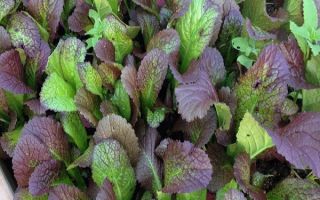Content
Mustard leaf belongs to the cruciferous family. It is a spicy plant with large wavy leaves, the height of which reaches 60 cm. It is widely used in Chinese cuisine, where the benefits and harms of mustard leaves have been studied for a long time. The taste is spicy, bitter, used fresh and in ready-made dishes. The culture is unpretentious, easy to grow, but it is not very popular in Russia.
The composition and calorie content of mustard leaves
In dietary nutrition, the benefits of mustard leaves are obvious, since the calorie content of 100 g of the product is 26 kcal. It includes:
- carbohydrates - 4.7 g;
- fats - 0.4 g;
- proteins - 2.9 g;
- dietary fiber - 3.2 g;
- water - 88.8 g.
The benefits of mustard leaf are rich in vitamins:
- vitamin A - is responsible for skin and eye health, reproductive function, high immunity;
- β-carotene - has antioxidant properties;
- vitamin C - helps the body in redox reactions, iron absorption.
The plant contains trace elements:
- potassium - 15%;
- calcium - 11%;
- copper - 16%.
Useful properties of mustard leaves
Due to its composition, the beneficial properties of mustard mustard have a beneficial effect on the overall health of the body when eaten. Among them:
- lowering cholesterol levels;
- reducing the likelihood of heart failure;
- high anti-inflammatory properties;
- activation of the intestines;
- increased immunity;
- restoration of the balance of useful minerals and vitamins;
- reducing the likelihood of cancer;
- strengthening of bone tissue;
- improving the properties of the skin by removing toxins from the body.
Harm of mustard leaf and contraindications
As with any product, in addition to benefits, mustard greens can also bring harm to the body. Healthy people are not in danger, unlike those who have pathologies.
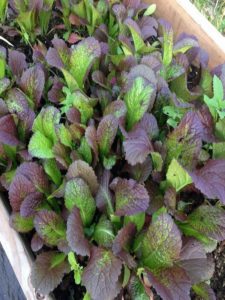
- in diseases of the gallbladder and kidneys, the properties of the leaves can provoke the formation of stones, since they contain oxalates;
- with exacerbations of peptic ulcer;
- for pregnant women, excessive enthusiasm for mustard can be harmful and provoke swelling;
- nursing mothers - due to the risk of an allergic reaction in the baby.
How to eat mustard leaves
The leaves taste like horseradish, green salad and mustard sauce. They can be used in preparations, marinades, salads, as a garnish for fish or meat. The peoples of Southeast Asia widely use mustard leaves in cooking, the benefits and harms of which for the body are well studied. They are used to decorate sandwiches and ready-made meals, but the mustard leaf is not just a decoration, but a source of nutrients. In America, the product is added to steaks, and in Italy pasta with mustard is popular.
In Russia, mustard was popular under Catherine II. It was grown, harvested: highly valued for the beneficial properties of the leaves, and then happily forgotten.Today, this popularity is returning: the plant is used in the industrial production of sauces and mayonnaises to give them a spicy taste. Salads and preparations are simple and healthy to perform.
Mustard Leaves Recipes
Culinary uses are not limited to specific recipes. Applying imagination, you can flavor any dish with a product, giving it a new spicy taste.
Sandwich pasta
For cooking you need ingredients:
- mustard leaves - 50 g;
- cheese - 100 g;
- butter - 1 tbsp the spoon.
Cooking method:
- Grate cheese.
- Chop the mustard leaves.
- Stir all ingredients.
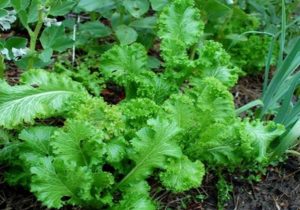
Okroshka
Okroshka contains:
- kvass - 1 l;
- mustard - 2 leaves;
- cucumber herb 40 g;
- salad - 5 leaves;
- green onions - 30 g;
- dill - 15 g;
- boiled eggs - 2 pieces;
- potatoes - 1 piece;
- meat -40 g;
- sour cream, salt, sugar - to taste.
Cooking procedure:
- Grind all the spices.
- Grind the cucumber herb with the yolks.
- Finely chop meat, potatoes, proteins.
- Mix all the ingredients, pour in kvass.
- Season with sour cream, salt, sugar.
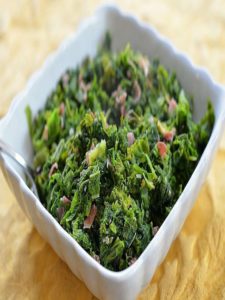
Sandwich
The snacks include:
- mustard leaves - 6 pieces;
- mayonnaise - 1 tbsp. the spoon;
- bread - 6 slices;
- butter to taste.
Cooking method:
- Finely chop the leaves, mix with mayonnaise.
- Spread the mixture over 3 slices of bread;
- Spread 3 slices of bread with butter.
- Combine pieces of bread in pairs, grease on top with the remaining mustard and mayonnaise.
Salad
For cooking you will need:
- mustard leaves;
- vegetable oil;
- lemon juice;
- parsley and basil.
Cooking method:
- Rinse the leaves, dry, cut.
- Season with lemon juice and oil.
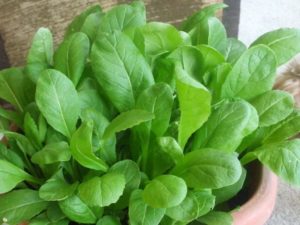
How to choose and store mustard greens
Since when comparing the benefits and harms of mustard herb, the preponderance is always on the side of the positive properties of the plant, the question arises about the possibility of preserving the product as long as possible. Such a storehouse of useful vitamins will come in handy at any time of the year. Harvesting of greenery begins at the moment when the leaves reach a size of 15 - 20 cm in height. This occurs in the third week after seed germination.
In a refrigerator at a temperature of 4 ° C, dried greens can be stored without losing their beneficial properties for about a week. You can take care of it like a bouquet - in a glass jar with water. But these methods are short-lived: they extend the use of useful leaves for a maximum of two weeks. To preserve the benefits for a longer period, it is worth using other methods:
- freezing - dry the washed greens, put them into portions in foil and place in the freezer;
- cubes - crushed leaves are filled with water and frozen in ice molds;
- drying - carried out outdoors, in an electric dryer or in a warm place;
- salting - by placing in containers with a large amount of salt.
The last method of storing mustard is the least preferable, since the benefits of the plant are offset by the excess amount of salt, the harm of which in excess amounts has been proven.
Growing mustard leaves
The culture loves loose, fertile, moist soils with neutral acidity. Along with open ground, it may well grow on a balcony, in a greenhouse, on a windowsill.
In autumn, rotted compost, superphosphate (1 tsp per 1 sq. M) are introduced into the soil. Sawdust, river sand must be added to clay soil. With the onset of spring, the soil is dug up to a depth of 20 cm, and beds 15 cm high are formed if the soil is heavy. With an easy one - you should not do the beds.
Sowing is carried out as early as possible, since the plant belongs to crops of long daylight hours. You can sow at intervals of 2 weeks in order to have greens constantly in summer. Seeding depth - 1 cm, row spacing - up to 20 cm. You can not cover them with soil, but only cover them with foil.Germination occurs at a temperature of 3 ° C, seedlings tolerate light frosts.
Further care consists in accurate, frequent watering and weeding. With thickened seedlings, it makes sense to thin them out, leaving seedlings after 3 cm in order to prevent shooting. If there is not enough moisture, the leaves coarsen.
After reaching ripeness, they can be plucked, or plucked out with rosettes, and then stored together with the roots in the cellar. Greens are harvested when there is no dew on the foliage.
If there are no contraindications, then due to its beneficial properties, mustard leaf can become a constant source of vitamins grown directly on the windowsill - in sawdust and even cotton wool.
Conclusion
Before picking up the seeds of this plant, it is worth finding out what the benefits and harms of mustard leaves are. If there are contraindications, it is worth consulting your doctor. In retail chains, this greenery can be found not so often. The more pleasant it will be to get the harvest on your own and make the dishes of your table tastier and healthier.

